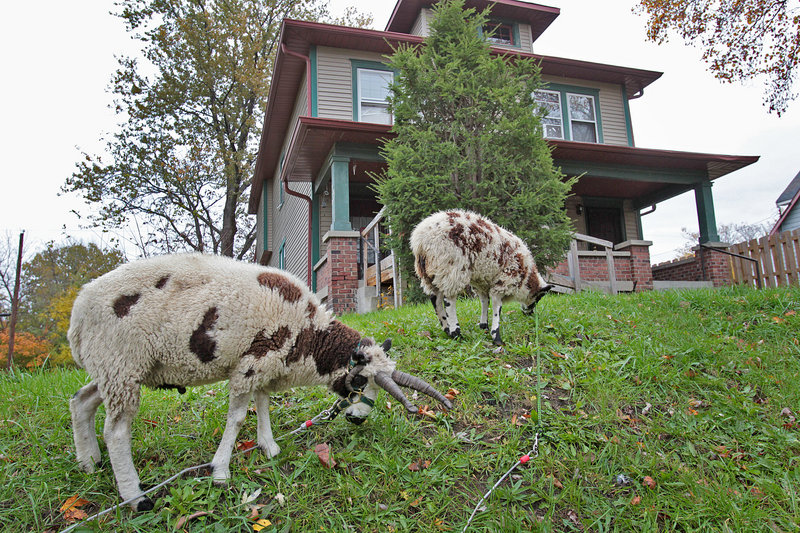INDIANAPOLIS – Many things come to mind when someone mentions the Near Eastside of Indianapolis.
Boarded-up homes and vacant lots. Quirky stores and new development along East 10th Street. Sadly, shootings, drug dealing and prostitutes. The Super Bowl-supplied Legacy Center. Sheep.
Yes, sheep.
Two of them, to be exact. Twisty and Lily are their names and they live, for the moment anyway, in the backyard of a Jefferson Avenue home.
By day, they graze in vacant lots near the Indianapolis Re-entry Education Facility. It’s quite a sight. Two Jacob sheep chomping away on overgrown grass mere feet from a 25-foot-high fence separating the public from inmates. The sheep chew calmly as cars speed by along East New York Street, and men hang out on porches talking and drinking, not even glancing at Twisty and Lily.
Why are there sheep on the Near Eastside, of all places?
Simple: Sheep mowing.
The Near Eastside has an enormous number of vacant lots with overgrown grass and weeds, and almost as many abandoned houses. Instead of calling the city to take lawn mowers to those lots, or a letting a handful of good Samaritans do it themselves, the neighborhood association decided to buy sheep and let them graze.
It’s not as crazy as it sounds.
In Italy, for example, there’s at least one town where residents bring in sheep to mow their city parks in the winter.
Here in Indianapolis, in this very urban setting of fence-lined vacant lots filled with broken glass, cans and other trash, the sheep actually do a better job than the city’s lawn mowers. They eat around the debris, up and down steep hills, and they get the weeds along fences where vermin tend to hide and breed.
Still, they’re sheep . . . on the Near Eastside.
“They’re local celebrities because people stop and take their pictures with their phones on a regular basis,” said Sue Spicer, president of the Willard Park of Holy Cross-Westminster Civic Alliance.
Spicer, with her partner, Kay Grimm, came up with the idea of sheep mowing their neighborhood. They bought Twisty and two other sheep in May.
The other two sheep were stubborn.
“They just wouldn’t allow themselves to be caught,” she said. “They are magnificent creatures in terms of their athleticism.”
Spicer and Grimm eventually decided to have the first two sheep slaughtered. They sold most of the meat, with the proceeds going to buy supplies to support Twisty and Lily.
“Boy, do those chops taste good,” Spicer said.
But she worries regularly that someone in the neighborhood will try to kill Twisty and Lily to eat them. Once, the sheep had a close encounter with a hungry man wielding a hammer. She’s also heard more direct solicitations.
“How much for your sheep?” she says people ask. “We’re having a cookout.”
The goal, however, is to keep these two particular sheep alive — and maybe add a few more to have a herd of five that moves from lot to lot across a larger swath of the Near Eastside. First, though, they need a full-time shepherd. The hope is to get a veteran with post-traumatic stress disorder to take the job. Live a mobile lifestyle in a tent with a stove, going from lot to lot and watching the flock.
Grimm works regularly with veterans and said it’s not out of the question. Those who are homeless and living, say, downtown under a bridge in a tent might be interested in such an undertaking.
Spicer, for her part, is just looking forward to UPS delivering a solar-powered electric fence to help protect the sheep and allow The Green Shepherd Project to grow. First things first.
“We’d much rather look like an English estate,” she said, “than city-mowed.”
Copy the Story Link
Send questions/comments to the editors.



Success. Please wait for the page to reload. If the page does not reload within 5 seconds, please refresh the page.
Enter your email and password to access comments.
Hi, to comment on stories you must . This profile is in addition to your subscription and website login.
Already have a commenting profile? .
Invalid username/password.
Please check your email to confirm and complete your registration.
Only subscribers are eligible to post comments. Please subscribe or login first for digital access. Here’s why.
Use the form below to reset your password. When you've submitted your account email, we will send an email with a reset code.